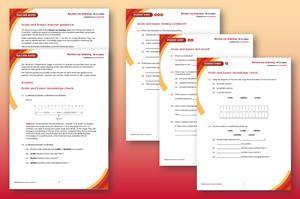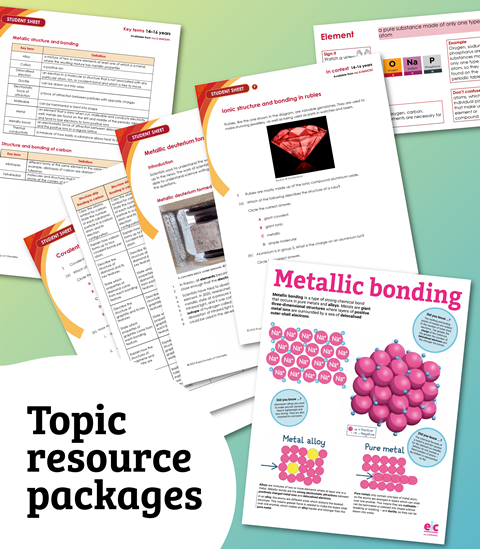Review your learners’ understanding of key ideas, words and phrases relating to acids and bases
This resource features three different versions of a worksheet on acids and bases: scaffolded, partially scaffolded and unscaffolded. Use the worksheets to identify learners’ knowledge gaps and misconceptions once you have taught this part of the curriculum. Find out more about how to use this resource or download the worksheets below.
-

Download this
Download the scaffolded, partially scaffolded and unscaffolded student worksheets.
You will find model answers in the teacher guidance.
View and download more Review my learning worksheets
Curriculum topics
These Acids and bases worksheets cover the following topics:
- the pH scale
- the pH of acidic and alkaline solutions
- common acids and alkalis
- general word equations for the reactions of an acid with a metal, metal oxide, metal hydroxide and a metal carbonate
- chemical formulas of common laboratory acids
- types of salts produced from reactions with hydrochloric acid, sulfuric acid and nitric acid
- universal and litmus indicators.
If learners successfully answer questions on these topics, they can attempt the extension questions. These cover:
- word equations for the reactions between an acid and a metal, metal oxide, metal hydroxide or metal carbonate
- symbol equations for the reactions between an acid and a metal, metal oxide, metal hydroxide or metal carbonate.
How to use this resource
The worksheets can be used in a variety of ways:
- to assess learners’ knowledge at the beginning or end of a period of teaching. Match the level of the worksheet to the support needs of the learners;
- to assess knowledge during a period of teaching once learners have completed the relevant topic;
- as part of revision;
- as a refresher exercise for teachers or non-subject specialists.
Scaffolding
Three levels of support, provide options depending on the diverse support needs of learners. An editable version of each worksheet provides further opportunities to adapt the resources to meet individual learning needs. There is also scope to increase the level of the worksheets used, as learners progress through their curriculum.
Independent learning and metacognition
The ‘What do I understand?’ page is common to all worksheets. Learners are encouraged to develop independent learning skills and can use their reflection as a guide for revision. The feedback will also help you to identify areas where a whole class needs attention.
Answers
The teacher guidance provides model answers for each worksheet, plus guidance on learners’ common misconceptions. Learners can use the model answers to self- or peer assess.
More resources
- Neutralise student difficulties with this Acids and bases: creating solutions CPD article from Education in Chemistry
- Make lessons on acids and bases inclusive to all with these ideas for supporting learners with sensory and motor impairments.
- Add context and inspire your learners with our short career videos showing how chemistry is Making a difference.
Downloads
Acids and Bases | student worksheet | fully scaffolded
Handout | PDF, Size 0.28 mbAcids and Bases | student worksheet | partially scaffolded
Handout | PDF, Size 0.31 mbAcids and Bases | student worksheet | unscaffolded
Handout | PDF, Size 0.25 mbAcids and Bases | teacher guidance and answers
Handout | PDF, Size 0.35 mbAcids and Bases | student worksheet | fully scaffolded
Editable handout | Word, Size 0.13 mbAcids and Bases | student worksheet | partially scaffolded
Editable handout | Word, Size 0.13 mbAcids and Bases | student worksheet | unscaffolded
Editable handout | Word, Size 0.13 mbAcids and Bases | teacher guidance and answers
Editable handout | Word, Size 0.15 mb


















No comments yet